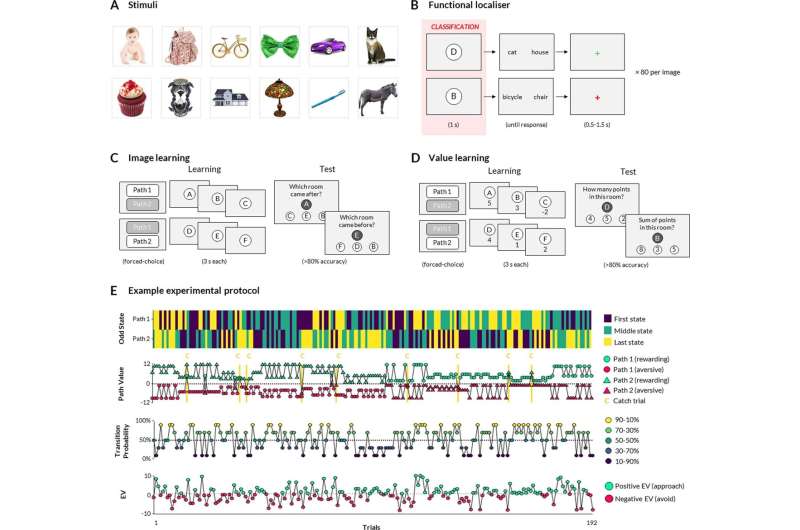
Past neuroscience studies suggest that when deciding their next actions, mice and other rodents tend to replay past outcomes of similar situations in their brain, which is reflected in a rapid activation of certain brain regions in a sequence. Recently, some studies recorded similar replay-associated brain activity in the human brain using imaging techniques.
Researchers at University College London (UCL) have carried out a study exploring the possibility that this rapid “replay” of past positive and negative outcomes could predict the choices that humans make in a situation where they could either lose or gain money. Their findings, published in Nature Neuroscience, unveil a possible link between replay in the brain and the planned behavior of humans, suggesting that while choosing to approach or avoid a situation, humans mentally represent the worst-case scenario that could result from their choice.
“This work was inspired by the many new discoveries that have been made about ‘replay’ in the brain,” Jessica McFadyen, one of the researchers who carried out the study, told Medical Xpress. “Rodents tend to replay paths towards rewards (planning where to go), but also tend to replay paths that could lead to an electric shock (planning where not to go). So, what happens when we’re not sure if a path leads to reward or to punishment? This is what interested me.”
The key objective of the recent study by McFadyen and her colleagues Yunzhe Liu and Raymond J. Dolan was to examine how different paths are replayed in the human brain in situations where the outcome is not easy to deduce. Specifically, they examined scenarios in which humans might be conflicted about whether to approach or avoid a given path, a dilemma known as the approach-avoidance conflict.
“Choosing whether to stay (avoid) or go (approach) is hard when we’re uncertain, and it’s possible that replay in the brain could explain how we eventually make up our mind,” McFadyen said. “To test this hypothesis, we used a brain imaging technique called magnetoencephalography, which entails the use of a machine that sits on the scalp to pick up the tiny electric currents that pass through human neurons.”
Magnetoencephalography allows researchers to precisely measure bursts of activity in different areas of the brain and when they occur. McFadyen and her colleagues specifically used it to measure the very fast bursts of brain activity that happen in the brain during replay, which are only about 40 milliseconds apart.
They recorded these bursts of activity in 25 participants who were asked to take part in a simple picture-based game. During this game, the participants were presented with different scenarios where they had to choose whether to approach or avoid a particular path.
“The paths were just sequences of images, and participants learned which sequences would end with positive points (bonus money) or negative points (no bonus money),” McFadyen explained. “A key factor was that, if participants chose to approach, they might not be able to get to the path they wanted. There was always some probability (e.g., 30% chance) that they would get sent to a more dangerous path. While participants deliberated on whether to take the risk or not, we captured the brain activity we were most interested in, namely that associated with replay during approach-avoidance conflict.”
After they collected their brain recordings, the researchers used machine learning to analyze them and determine which of the images they were previously presented with were replayed in the brain while participants made a new decision. In other words, the models they used detected the re-activation of sequences of brain activity that were first recorded while the participants were initially presented with a given image.
By analyzing these results in combination with the decisions that participants took (i.e., whether they approached or avoided a given situation), McFadyen and her colleagues were then able to determine what sequences were being replayed before participants decided to approach or avoid a given path.
“Our biggest finding was that humans play out paths of the worst-case scenario,” McFadyen said. “If participants eventually decided to avoid altogether, they tended to replay (or rather ‘simulate’) paths leading to the desired but forgone reward. On the other hand, if participants eventually decided to approach and take the risk, they tended to replay paths leading to the feared negative outcome. This sort of counterfactual thinking could be a way for the brain to make sure we don’t forget alternative outcomes.”
The findings gathered by this team of researchers offer some interesting new insight about what past experiences humans tend to replay in their brain before deciding whether to approach or avoid a certain situation. In the future, they could inform additional works exploring the links between replay and decision-making, while also potentially improving our understanding of problematic avoidant behaviors associated with anxiety disorders and other psychiatric conditions.
“There are many places where this research could take us,” McFadyen added. “One avenue would be to further investigate how to better measure replay in the human brain, as it is challenging to get reliable measures even with machine learning. Another avenue would be to then further investigate how replay relates to negative simulations of the past and the future that play a critical role in depression and anxiety. If we better understand where in the brain these simulations occur, and how spontaneous or controllable they are, then we can better guide mental health treatments.”
More information:
Jessica McFadyen et al, Differential replay of reward and punishment paths predicts approach and avoidance, Nature Neuroscience (2023). DOI: 10.1038/s41593-023-01287-7
Journal information:
Nature Neuroscience
Source: Read Full Article
